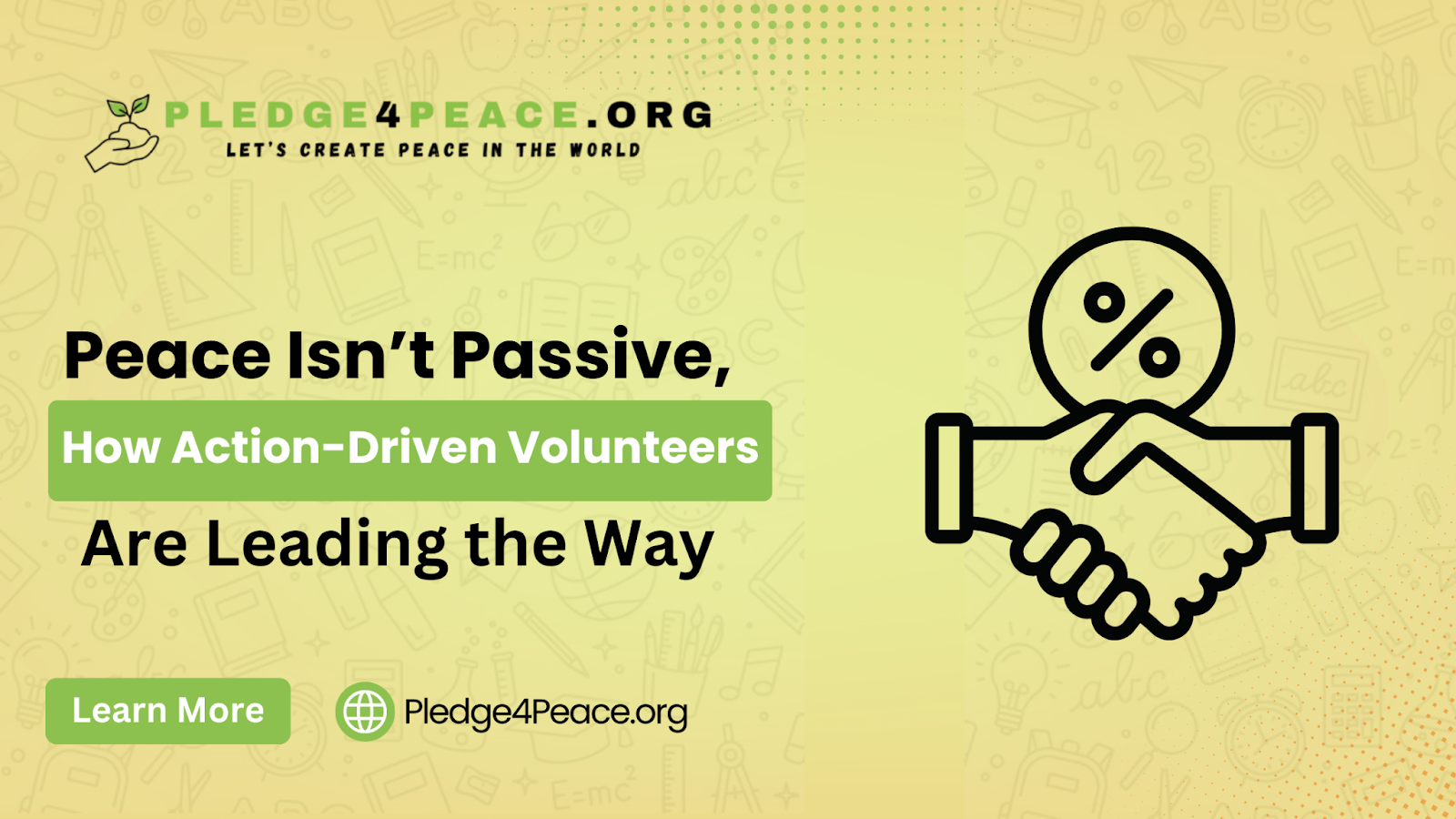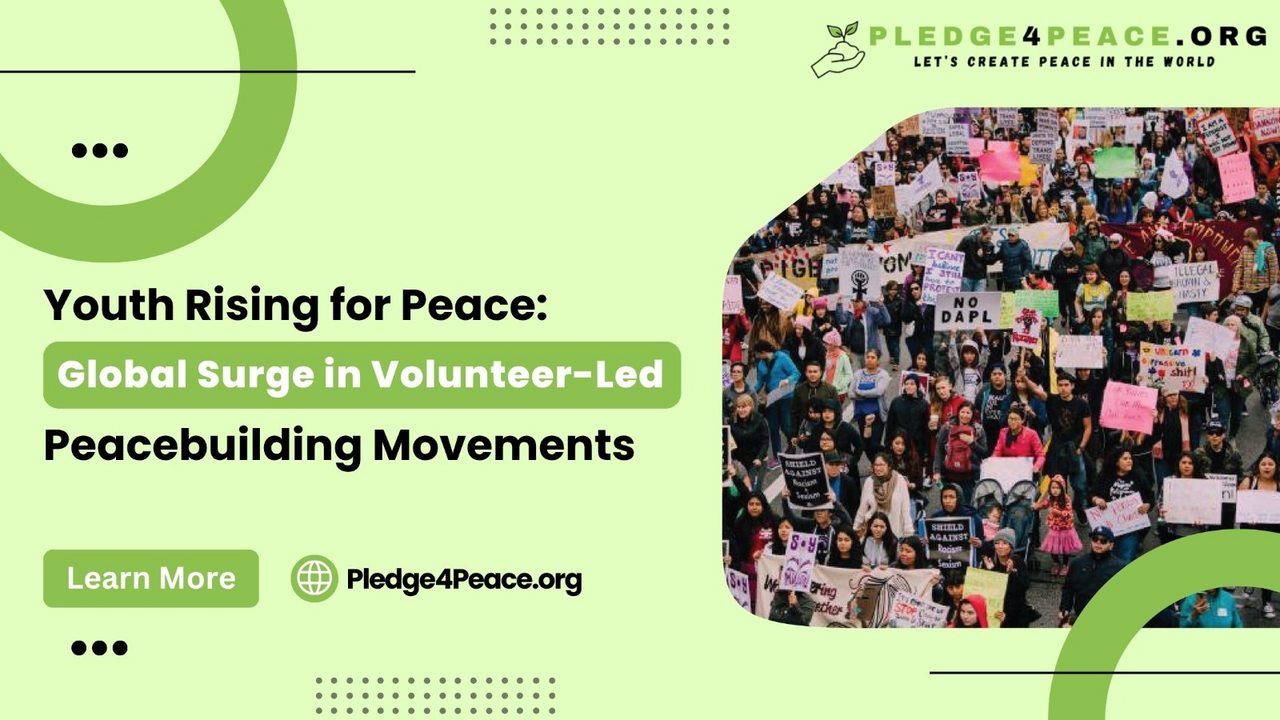Peace Isn’t Passive: How Action-Driven Volunteers Are Leading the Way

In a world where conflict dominates headlines and digital noise often overshadows acts of kindness, one truth remains: peace isn’t passive. It doesn’t simply appear when war ends or when anger settles. Instead, peace is actively nurtured, cultivated by individuals who dedicate their time, passion, and energy to building better communities. These individuals are known as volunteers, and they are the silent warriors of modern society.
As we navigate an increasingly polarized world, the role of volunteers in promoting peace is more crucial than ever. These are the people who show up, not for fame or reward, but for the cause of humanity. They plant seeds of understanding, offer empathy where none exists, and build bridges in spaces where walls once stood. In 2025, the call for active peacebuilding is louder, and volunteers are answering it with action, creativity, and purpose.
Peace: Not the Absence of War, But the Presence of Action
For too long, peace has been misunderstood as silence, calm, or simply the absence of violence. But in truth, peace is a dynamic, living process. It thrives in spaces where people listen, communicate, forgive, and grow together. Peace is found in classrooms that teach tolerance, in neighborhoods that support the vulnerable, and in dialogue circles that turn strangers into allies.
In every corner of the globe, volunteers are redefining what peace means. They are engaging in efforts ranging from local clean-up drives to global campaigns for human rights. Their actions are not grand gestures captured in history books, but rather small, consistent steps that ripple across society.
The Rise of Peace Volunteers in 2025
As the world becomes more interconnected, the avenues for volunteering in peacebuilding have expanded dramatically. Social media, virtual communities, and global collaboration have allowed volunteers to transcend borders, cultures, and language barriers. In 2025, peace volunteers are no longer confined to traditional activism; they are using technology, storytelling, and innovation to reach new audiences.
Youth groups are creating peace clubs in schools. Artists are designing murals that inspire tolerance. Digital volunteers are running awareness campaigns for mental health, refugee rights, and climate justice. Each act, no matter how small, contributes to a larger narrative of healing and hope.
The power of these volunteers lies not in their numbers but in their commitment. They understand that to truly make a difference, one must move from intention to action. They don’t wait for institutions to act, they take responsibility into their own hands.
Volunteers as Architects of Peaceful Societies
The contribution of volunteers to peace is not abstract or symbolic, it is measurable, impactful, and transformative. They work in conflict zones, provide humanitarian aid, support trauma victims, and facilitate cross-cultural exchange. By being present where they are most needed, volunteers become the architects of resilient and peaceful societies.
In refugee camps, volunteers teach children who’ve never seen the inside of a classroom. In urban slums, they offer counseling to youth at risk of joining gangs. In remote villages, they mediate disputes between families. These volunteers are not passive observers, they are engaged citizens driving change from the ground up.
Governments and nonprofits have increasingly recognized the power of volunteering in peacebuilding. Programs are being designed to equip volunteers with the tools, training, and platforms they need to amplify their efforts. But at the heart of it all is still the volunteer, the individual who chooses to give their time for the greater good.
Peace Through Action: Real Stories of Volunteers Making a Difference
Take the example of Ayesha, a young volunteer from Karachi who launched a campaign promoting interfaith harmony through storytelling workshops. Her sessions brought together students from different religious backgrounds and encouraged them to share their cultural traditions and values. What started as a small local project turned into a city-wide movement, inspiring dozens of similar initiatives across Pakistan.
Or consider James, a retired teacher in Uganda who volunteers to teach conflict resolution to young men in high-risk communities. His workshops have helped reduce local crime and fostered cooperation among rival groups. His message is simple: “Peace starts with how we treat each other every day.”
These stories remind us that volunteers are not just participants, they are catalysts. Their presence in communities under stress provides reassurance and hope. Their energy becomes contagious, mobilizing others to act with kindness and courage.
Digital Volunteers: Peacebuilding in the Age of Technology
The digital age has opened new frontiers for volunteers who promote peace. Online forums, virtual campaigns, and social platforms now serve as arenas for activism. Whether it's fighting cyberbullying, spreading awareness about mental health, or countering hate speech, digital volunteers are playing a vital role in shaping a peaceful online culture.
Organizations have also started training virtual peace ambassadors. These are volunteers who facilitate online workshops, moderate discussions, and create educational content that spreads positivity and tolerance. Their reach is vast, and their impact is felt across continents.
In conflict-prone regions where physical presence can be risky, digital peace volunteers offer a safe and effective alternative. They support online counseling, conduct remote training, and even provide emergency resources through apps and websites.
The Mental Health Impact of Peace Volunteering
Volunteering for peace not only benefits society, it also nurtures the individual. Numerous studies show that those who engage in peace-driven volunteering experience improved mental health, a stronger sense of purpose, and deeper emotional connections with others.
The act of helping others reduces stress, combats depression, and fosters resilience. Volunteers often report a sense of fulfillment that comes from making a difference, however small. In an age where mental health challenges are widespread, peace volunteering serves as both a remedy and a mission.
Whether you are facing burnout, loneliness, or a lack of direction, volunteering for peace can provide clarity and healing. It allows you to step outside of yourself and become part of something larger, more meaningful, and more lasting.
How to Become a Peace Volunteer
Becoming a peace volunteer doesn’t require a degree, a title, or a specific background. All it takes is the willingness to act. Here are some ways you can get involved:
- Join a Peace Organization: Look for NGOs and platforms like Pledge4Peace and other local groups promoting peace.
- Start a Local Initiative: Organize community cleanups, reading circles, or awareness walks.
- Use Your Skills: Whether you’re an artist, teacher, coder, or writer, your skills can promote peace in unique ways.
- Go Digital: Become an online peace ambassador, create content, or manage social campaigns.
- Speak Up: Promote positive narratives in your workplace, classroom, and social circle.
Remember, every step toward peace, no matter how small, is a step worth taking.
Volunteers Are the Heartbeat of Peace
In a world grappling with division and discord, volunteers are the heartbeat of hope. They remind us that peace is not an abstract concept or an unreachable dream, it is something we build every day through choices, conversations, and compassion.
Their work may not always make headlines, but it shapes lives, communities, and the future. When you support a peace volunteer, you support a vision of the world that is kinder, safer, and more united.
Peace Isn’t Passive, It’s Personal
The message is clear: peace requires action, and that action begins with us. Whether through a smile, a shared meal, a conversation, or a campaign, each of us has the power to contribute. In the face of violence, indifference, and hatred, volunteers choose empathy, presence, and courage.
Let us not wait for peace to be delivered from above. Let us rise with the volunteers who are already leading the way. Their message is powerful, and their example is necessary.
Because peace isn’t passive.
Peace is the choice to care, to act, and to keep going, no matter how hard the road may seem.
You can be part of the change too, become a volunteer who turns peace from a dream into reality at Pledge4Peace.org

